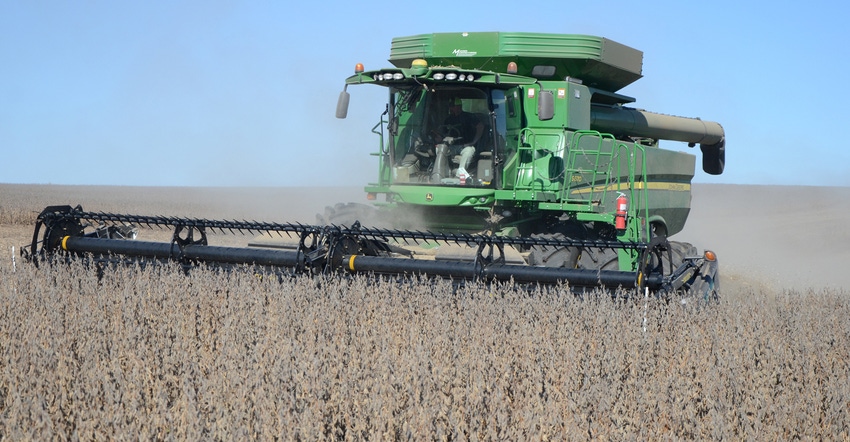
Jimmy Frederick made headlines when he broke the national soybean yield record in 2017 with 163-bushel-per-acre irrigated soybeans. In 2018, he broke another record, with 138-bushel rainfed soybeans. With 2019's extreme weather, the Rulo, Neb., farmer didn't set any records this year, but he did come remarkably close, considering this year's planting delays.
And like the past two years, Frederick reached these high yields with populations below 100,000 plants per acre. In October, he harvested 118.42-bushel-per-acre rainfed soybeans — with a population of 70,000 plants per acre.
"The main thing this year was trying to battle through the adverse weather," Frederick says. "Soybeans were planted way later than I'd like, and I think that's why the yield was lower this year. We would plant a day, wait three weeks, and plant another day. Then we had a hot, dry spell, and nothing had rooted down earlier, because nothing needed to because of the rain. During flowering and early pod set, we had a hard storm, hard wind and hail, and that didn't help at all. It was a constant battle."
Still, breaking 100 bushels per acre with sub-100,000 populations is nothing to sneeze at — although Frederick acknowledges those populations aren't as low as the 50,000 plants per acre on the 138-bushel-per-acre field he harvested in 2018.
Cutting back to populations below 100,000 may go against conventional wisdom, but he's been able to make up for it by adding more nodes and pods per plant. In many ways, it's a numbers game.
"These were managed similar to last year and were the same variety, but this year, higher populations did a little better than lower populations," Frederick says. "I'm sure it all comes back to planting date and growing degree units. My goal was to reach upward of 1,000 to 1,300 pods per plant. I think the most I got was 850, but I was averaging around 300 to 350 pods across all the plants I counted. This year, we had a slow start, and I think that might be what hurt my pod count."
He also had a plot with populations as low as 20,000 plants per acre, comparing two different Pioneer varieties. And one of those plots yielded 74 bushels per acre under rainfed conditions.
"Picking the right variety is huge," Frederick says. "One variety at 20,000 yielded 74, and the other yielded 47. They're row-to-row. As the population went up, I went from 20,000 to 100,000, and as the population came up, both yields came close together on the two varieties."
Since 2016, when Frederick first began ratcheting down his soybean populations, he began focusing on building soil biology through biological applications — which has helped shorten internodes and helped soybean plants stay shorter, growing a thicker main stem and more lateral branches.
This year, he used some new soil tests through Next Level Ag in Alpena, S.D. This included a water extractable organic carbon test. Jason Schley, co-owner and agronomist at Next Level Ag, notes this test serves as an indicator of the food source available to soil microbiology.
"It gives us an idea, should we be adding biology or a food source to help the biology we already have?" Schley says. "It also tells you about how much nitrogen your soil can hold. Generally, the higher the carbon in your soil, the more nitrogen it's going to tie up. If you have a high C-to-N ratio, it says you need to put more on upfront. We use it for a lot of different reasons, but it's a really good indicator of what that soil is capable of feeding as far as the bacteria and fungi go in the soil."
Frederick also applies a regimen of biological products; including Biovante's BioMate to provide sugars and two strains of bacteria that aid in sugar production; BioCore, a blend of microbials and talc to treat seed and help it germinate; and BioRed, a blend of biologicals to help give the carbon and nitrogen cycle a boost.
"With the nitrogen-fixing capabilities of rhizobium, there are chemistries in the strains Jimmy is applying that boost the plant's ability to capture nitrogen atmospherically and release N into the soil," explains Chris Masters, CEO at Biovante. "To have those kinds of yields, we have to have high microbial activity."
Masters says these biological applications also have helped make potassium more available to soybean plants later in the season.
"The need of potassium changes based on the population," Masters adds. "Lower populations should have lower K demands. Jimmy's getting higher yields with the 20,000, 40,000 and 60,000 populations compared to growers planting in the 140,000 to 160,000 range. But his efficiency with potassium and other nutrients is way higher."
"Many people are apprehensive to drop soybean populations below 100,000," Masters says. "You're creating something that's not been heard of. It's high-risk, high reward, but I think Jimmy would say we've found that optimum plant population based on soil conditions and their management practices. When matched up with the right variety, it's very successful."
About the Author(s)
You May Also Like






